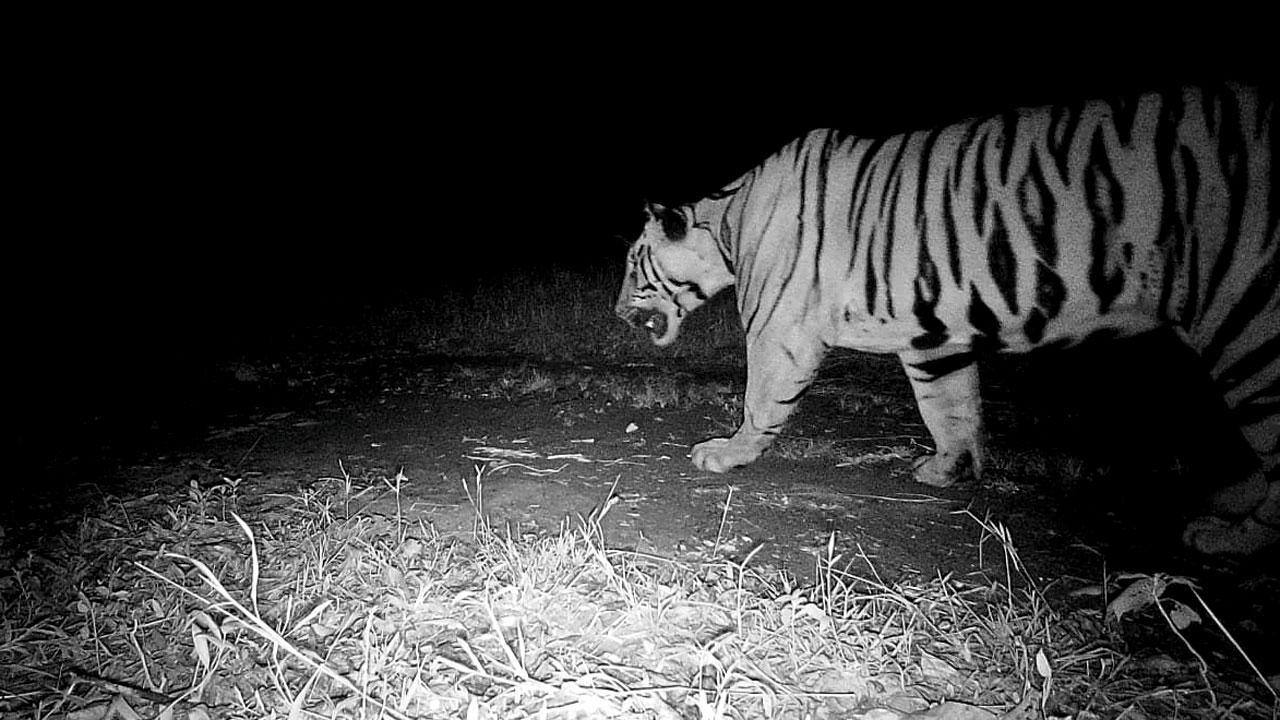Forest officials set up the camera traps near forest trails and water bodies after a labourer noticed pug marks of a big cat on December 12; officials say the development comes as a boost to the Tiger Recovery Programme

The tiger was captured by the camera trap at 4.59 am on Sunday, December 17. Pic Courtesy/Maharashtra Forest Department
Key Highlights
- The Maharashtra Forest Department has successfully captured a camera trap image of a tiger
- STR is spread across the Sangli, Satara, Kolhapur, and Ratnagiri districts of Maharashtra
- 2014 tiger census indicates that STR houses a modest population of five to eight tigers
The Maharashtra Forest Department has successfully captured a camera trap image of a tiger in Chandoli National Park within the Sahyadri Tiger Reserve (STR), marking a positive development for the ecology of Western Ghats. The STR is spread across the Sangli, Satara, Kolhapur, and Ratnagiri districts of Maharashtra.
Confirming the development, Dr V Clement Ben, additional principal chief conservator of forest, Western Wildlife Region Mumbai, said, “On December 17, one of the infrared camera traps installed at Chandoli National Park captured the image of a tiger. The sighting of the tiger points to the fact that tigers are using the Karnataka-Goa-Maharashtra tiger corridor. This is a very good sign and will help in the tiger recovery programme at STR.”
The 2014 tiger census indicates that the STR houses a modest population of five to eight tigers, determined through scat DNA analysis and model-based predictions. It is classified as a low-intensity tiger reserve, with the tigers being occasional visitors rather than resident, breeding individuals. In response to these observations, the forest department had taken steps to strengthen the corridor and improve the Tiger Recovery Programme (TRP).
Explaining the process of capturing the crucial photograph Ben added, “One of our forest labourers was doing his regular duty when, on December 12, he came across the pugmark of a big cat on a forest trail in Chandoli National Park. He alerted senior officials in the forest department, who later visited the spot and confirmed that the pugmarks were that of a tiger. Instructions were immediately given to set up camera traps on the forest trail and near water bodies. On December 21, when the officials checked the memory card from one of the camera traps, they found the image of the male tiger, taken at 4.59 am on December 17.”
During a visit to the STR in 2018, the National Tiger Conservation Authority (NTCA) also noted indirect indications of tigers’ presence—including pug marks and scat. In April 2018, the NTCA constituted a team comprising its officials and officials from the Wildlife Institute of India (WII), and the Maharashtra Forest Department to identify measures for tiger recovery within the STR, which has a core area of 600.12 square kilometres and a buffer zone of 565.45 square kilometres. The Chandoli National Park, an important portion of the STR, is located on the border of the Sangli, Kolhapur, and Satara districts. It is a UNESCO World Heritage site, designated in May 2004, spanning 122.65 square metres. It is a natural tiger habitat and part of the STR project.
“This is positive news. For the past several years, tigers in transit have been spotted from December to February in the STR and its corridor. This is healthy news for STR and proves a possible corridor from the southern part to the northwestern ghats of Maharashtra,” said Honorary Wildlife Warden of Satara, Rohan Bhate.
Previous sightings in STR
After an eight-year break, in May 2018, a tiger was photographed on camera traps in STR twice. In May 2019, too, a camera trap installed at Radhanagari Wildlife Sanctuary took the image of a young male tiger. Then in April 2022, the camera trap installed at Radhanagari Wildlife Sanctuary near Kolhapur captured the image of a tiger—the fourth time since 2012—highlighting the importance of the forests. Government reports highlight that bauxite mining in Kolhapur has impacted the connectivity of the STR with source populations and habitats in the southern regions, including Karnataka’s Kali Tiger Reserve.
On October 9, 2023, the technical committee meeting of the NTCA endorsed Phase II of the Tiger Recovery Program (TRP). This phase involves the soft release of eight tigers — four males and four females — in the STR. These tigers will be sourced from the Chandrapur landscape, which is marked by an overpopulation of large carnivores and a heightened level of human-animal conflict.
Dec 17
Day tiger was photographed
 Subscribe today by clicking the link and stay updated with the latest news!" Click here!
Subscribe today by clicking the link and stay updated with the latest news!" Click here!










